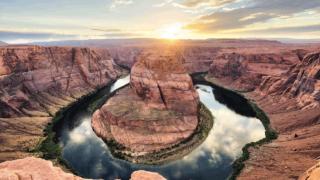
介绍:
A:Do you like visiting natural places?
B:Yes, I do. Being close to nature helps me release stress and worry.
A:What’s the most impressive natural scenery you’ve ever seen?
B:That’s the horseshoe of Colorado River in Arizona. It’s such a great scenic place on Earth.
A:When did you see it?
B:I visited the place last Summer holiday.
A:Who went with you?
B:I went there with my family. We camped near the place.
A:What’s special about it?
B:I’m fond of the great nature there. It’s a horseshoe-shaped meander of Colorado river.
A:How has it changed recently?
B:It doesn’t change much actually.
A:What’s the next natural scenery you would like to visit?
B:My next destination would be the Maroon Bells in Colorado. I fell in love with mountain ranges and yellow flowers there.
A:What can people get from visiting natural places?
B:People will get closer to Mother Nature. Children have more motivation to discover the world around them.
A:What are some famous natural attractions in your country?
B:There are many such as Death Valley, Niagara Falls, the Redwoods, and the Grand Canyon, to name a few.
A:你喜欢游览自然景观吗?
B:是的,我喜欢。亲近大自然帮助我释放压力和忧虑。
A:你见过的印象最深刻的自然景观是什么?
B:印象最深刻的是亚利桑那州科罗拉多河的蹄铁湾。那真是地球上一处绝美的景点呀。
A:你什么时候看到的?
B:我是在去年暑假游览了那里。
A:谁跟你一起去的呀?
B:我跟家人一起去的。我们在蹄铁湾附近露营来着。
A:那里有什么特别之处呀?
B:我很喜欢那里的自然景观。那是科罗拉多河的一处马蹄形的河湾。
A:它最近变化如何?
B:事实上并没有怎么变。
A:你想游览的下一处自然景点是什么?
B:我的下一处目的地将是科罗拉多州的马龙双子峰(褐铃山)。我爱那里的山峦叠嶂还有黄色的野花。
A:游览自然景点能为人们带来什么?
B:人们将会与大自然母亲变得更亲近。孩子们会有更多发现周围世界的动力。
A:你们国家有哪些有名的自然景点?
B:有很多,稍微列举几个:比如死亡谷、尼亚加拉瀑布、红木国家公园和大峡谷。
大家还在听

